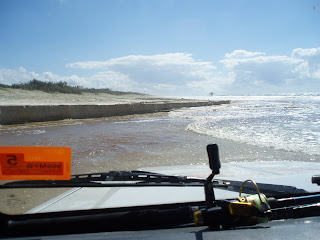Goodness, this has been a very full day. We left for Fraser Island at 8 a.m. with only overnight bags, as there isn't much room in the 4WD vehicles we are using. Everything else has been left at Rainbow Beach.
We drove down a long road surrounded by forest to Inskip Point, one of the places from which the ferry departs. The ferry doesn't have room for a lot of cars, but as it happened, there were only our two at that early hour. The ferry is just a flat platform with a ramp at either end and a tower at one side for the captain.

The trip only takes a few minutes, and then we were off driving on wild roads, or on the beach.
Fraser Island is off the Queensland coast, and is the largest sand island in the world, 76 miles long and 16 miles wide. It is a world heritage site, and is a mixture of hills and valleys, with a number of lakes of clear water. It is mostly thickly forested.
We began by driving across the island through the forest on a very dusty corrugated road which reminded me of roads in Kenya when I was a little girl. We drove right across the island on onto the beach at the eastern side. At this point, our vehicle began to smell as if it was overheating, and in fact we soon had to stop and send for help. We left the sick vehicle and driver and all crammed into the other vehicle and set off for Wobby Lake, driving along the beach and through some quite deep creeks. I was quite worried by more than one of these crossings, the water seeming quite deep and the sand not providing a good grip.
From the car parking spot, it was a 40 - 50 minute climb through the forest and across dunes to a sand blow which had the lake at its foot. We descended to the lake, and found the water to be very cold indeed, though a few people were swimming. We waded and admired the fish, which were over a foot long and kept coming to see what we were doing. We managed to photograph a heron and a couple of cormorants which were all resting on a branch probably after catching some of the fish - not, presumably the fish which were watching us, which were bigger than the birds.
After the 40 minute walk back to the car, we had undone all the pleasant cooling from wading in the cool waters. However, at least this time we were going down. The overheating car had been repaired, and we were no longer crammed together. We drove to a picnic spot called Happy Valley, where we made some lunch. A passing kookaburra stopped on a nearby branch to see if there might be anything for him, and we were able to get a reasonable photograph of him - or at least, I was. Paul's camera seems to have died.
We drove back to the beach, and along to a place called Eli Creek, which is a large and spectacular creek pouring gallons of water into the surf. It is lined with trees and pleasantly cool, and we waded along the creek. It varies between knee and thigh deep, and the water is completely clear and very cool, so it was lovely on such a hot day.
We continued along Seventy Five Mile Beach to view the wreck of the Maheno, which has been there for years (since some time in the 1930s) and is rusting away. Its demise has no doubt been hastened by the fact it was used for target practice during the last war. We drove on up the beach as far as Indian Head, and climbed the hill to visit the Champaign Pools. These are rock pools which are used for swimming, and are kept bubbling by the surf which breaks over the rocks which form them.
They did look very inviting, but a very cold wind had sprung up, and nobody was anxious to take off their clothes again, so we went back to the cars.
The next stop was at a viewpoint where you could see the beaches stretching away in both directions. The rocks were very slippery and the climb was steep, and as I was rather tired by then, I decided to stay in the car. There was plenty to look at on the beach, lots of washed up jellyfish, oystercatchers which were not in the least timid, and whales breaching well offshore. We had omitted to bring the binoculars, so we didn't have a clear view of them.
On the drive back, we passed two dingos and managed to get photographs. The first one was digging in the sand, as he had found some fish trimmings left by a fisherman. The second was just walking on the sand. He was wearing a tag, so had obviously been caught and tagged at some time.
I was pleased we had seen real wild dingos - I didn't see one at all last time I was here.






No comments:
Post a Comment